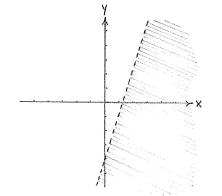Solution 2.2:8b
From Förberedande kurs i matematik 1
(Difference between revisions)
m (Robot: Automated text replacement (-[[Bild: +[[Image:)) |
m |
||
| (2 intermediate revisions not shown.) | |||
| Line 1: | Line 1: | ||
| - | + | A point whose coordinates satisfy <math>y < 3x-4</math> has a ''y''-coordinate which is less than that of a point lying on the line <math>y=3x-4</math> and having the same ''x''-coordinate. This means that the area we should shade consists of all points below the line <math>y=3x-4</math>. | |
| - | < | + | |
| - | + | ||
[[Image:2_2_8_b.gif|center]] | [[Image:2_2_8_b.gif|center]] | ||
| + | |||
| + | |||
| + | We can draw the line <math>y=3x-4</math> by choosing two ''x''-values, for example | ||
| + | <math>x=0</math> and <math>x=1</math>, using the equation of the line to calculate the corresponding ''y''-coordinates, <math>y=3\cdot 0-4=-4</math> and <math>y=3\cdot 1-4=-1</math> respectively, and then draw a straight line between the two points that we have obtained. | ||
Current revision
A point whose coordinates satisfy \displaystyle y < 3x-4 has a y-coordinate which is less than that of a point lying on the line \displaystyle y=3x-4 and having the same x-coordinate. This means that the area we should shade consists of all points below the line \displaystyle y=3x-4.
We can draw the line \displaystyle y=3x-4 by choosing two x-values, for example
\displaystyle x=0 and \displaystyle x=1, using the equation of the line to calculate the corresponding y-coordinates, \displaystyle y=3\cdot 0-4=-4 and \displaystyle y=3\cdot 1-4=-1 respectively, and then draw a straight line between the two points that we have obtained.

